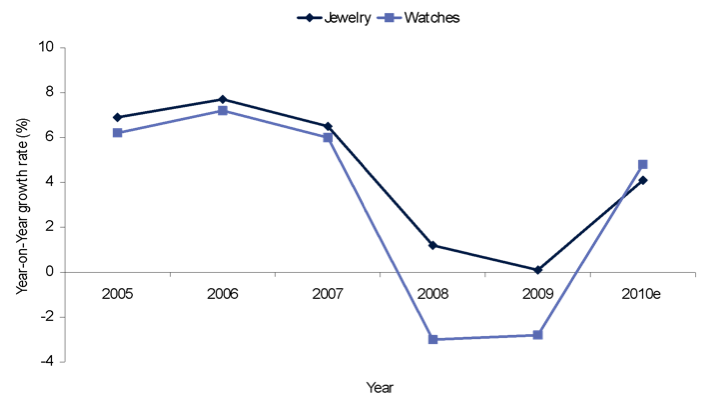
Retailers like Michael Hill has performed well despite the global economic crisis
Australia buoys Asia Pacific jewellery market
 3.1 k views | Posted November 30, 2010
3.1 k views | Posted November 30, 2010 |
By Sonia Nair
Australia, India and China have been singled out as key to Asia Pacific’s outperformance in the watch and jewellery market during the Global Economic Crisis.
Asia Pacific v the rest of the world
The Asia Pacific region, excluding Japan, is the fastest growing jewellery and watch market in the world, according to a study by market analyst firm Datamonitor, and constitutes 31.2 per cent of the global market at present.
It overtook the Americas in 2008 as the largest jewellery and watch market. In the past five years, the Asia Pacific market has increased its value by 51.5 per cent – more than twice the global average.
The study projected that the Asia Pacific region alone would spend $74.2 billion in 2010 on luxury and mass market produced watches and jewellery.
The firm attributed the exponential market growth to the development of buoyant consumer markets in three key territories – India, China and Australia.
“The region is dominated by two vast and fast-growing jewellery markets, China and India, both notable as major jewellery producers as well as consumer markets,” the study said.
According to the study, China is a major producer and exporter of pearl, gold, platinum and jade jewellery while India is the world’s largest consumer of yellow gold and the third largest of diamond jewellery.
Datamonitor retail associate analyst Ruta Perveneckaite said, “Younger generations of Chinese customers are less inclined to save and are particularly interested in luxury brands, while in India there is a strong tradition of gift giving with jewellery being one of the most popular gifts.”
The study said Australia’s relatively buoyant economy meant the global economic downturn did not affect retailers like Prouds Jewellers and Michael Hill as much as their European or US counterparts.
Michael Hill even lifted its operating margin by opening eight new stores in Australia in the year leading up to June 2009.
The study credited Australia’s booming luxury market to a continuing demand for commodities and the effective stimuli package.
Jewellery v watches

Data collated between 2005 and 2010 shows that watches had kept pace with jewellery until 2008 (see table). Jewellery accounted for 83.3 per cent of the global market total compared to watches and its 16.7 per cent of global market share in 2009.
Perveneckaite explained why jewellery outperformed watches. “Consumers are often unwilling to make compromises on precious jewellery to save money, especially on wedding jewellery.”
During the economic turmoil, jewellery companies expanded their market base with low-price jewellery by using cheap materials or developed branded, exclusive ranges with more defensible price points.
By contrast, Perveneckaite said market conditions for watches suffered during the GFC. “High-end department stores significantly cut back on their orders of watches during the recession and offered substantial discounts.”
Despite cutting down on orders, watch companies did not anticipate the severity of the downturn and still ended up with excess stock.
Luxury v mass market
Datamonitor forecast that consumers will spend $56.4 billion worldwide on the luxury market in 2010 – a $4.3 billion increase from 2009. As more affluent consumers find themselves in better financial situations, the firm said they are likely to buy high-end goods that they had denied themselves since the global downturn hit.
However, Perveneckaite said, “We do expect luxury jewellery market share to increase at the expense of mass market, but mass market will still take up most of the market since it is affordable for significantly more people.”
Market segment
|
2005
|
|
| 2006
|
| 2007
|
2008
|
| 2009
|
2010e
|
Luxury ($bn)
|
41.9 |
|
| 48.7
|
| 57.3 |
57.4
|
| 52.1
|
56.4 |
Mass market ($bn)
|
157 |
|
| 165.3
|
| 170.4 |
171.4 |
| 175.6
|
181 |
Total ($bn)
|
198.9 |
|
| 214
|
| 227.7 |
228.7 |
| 227.8 |
237.4
|
*e=estimated
More reading:
Luxury market in recovery
Luxury jewellery and watches digitally paralysed
Image Gallery (2 Images)